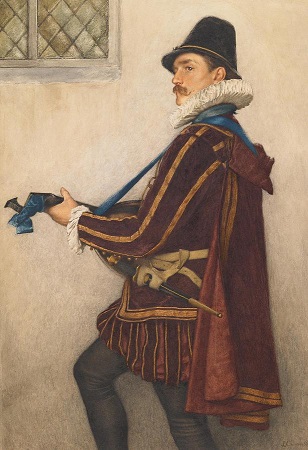Antica aria anglo-scozzese “Tweedside” o “The Banks of the Tweed” è alla base di molte canzoni tra Scozia e Irlanda e la questione è ancora aperta in merito alla paternità: “It is the tune Tweedside’, first published in the Orpheus Caledonius Collection in 1733… It was taken into the Irish tradition and combined with a text in Irish in praise of the river Lee, to give the well known ‘Abha na Laoi’ (The River Lee’)… The tune is now better known as ‘Ar Éirinn ní Neosfainn Cé Hí’ (‘For Ireland I would not tell her Name’), with its eighteenth-century text from the Maigue school of poets from Limerick… In this version the air, with its decorations, has been finally put into what traditional musicians of today would recognise as an acceptable Irish mould” (tratto da “Traditional music in Ireland” di Tomás Ó Canainn)
 Alcuni attribuiscono la melodia al compositore piemontese Davide Rizzio (o Riccio) (c. 1533 – 1566) protégé della regina di Scozia (vedi) e tuttavia il primo riscontro risale al 1622 scritto da Andrew Adam di Glasgow in tablatura per viola da gamba come riportato nel manoscritto Blaikie. Un’approfondita ricerca nel saggio di Cynthia Cathcart parte proprio dalle notazioni d’epoca barocca per risalire fino al 1800 (Tweedside — For Ireland I’d Not Tell Her Name
Alcuni attribuiscono la melodia al compositore piemontese Davide Rizzio (o Riccio) (c. 1533 – 1566) protégé della regina di Scozia (vedi) e tuttavia il primo riscontro risale al 1622 scritto da Andrew Adam di Glasgow in tablatura per viola da gamba come riportato nel manoscritto Blaikie. Un’approfondita ricerca nel saggio di Cynthia Cathcart parte proprio dalle notazioni d’epoca barocca per risalire fino al 1800 (Tweedside — For Ireland I’d Not Tell Her Name
The Melody and Lyrics of a Traditional Song vedi)
Il primo abbinamento della melodia con un testo è fatto risalire nella ricerca di Cynthia Cathcart a John Lord Yester, Marchese di Tweeddale presumibilmente scritto prima del 1697 e pubblicato ne Ancient and Modern Scottish Songs di David Herd (Edimburgo 1776) con il titolo di “When Meggy and me were acquaint” . Sempre nel Settecento viene pubblicata nel “The Tea–Table Miscellany” (1724) la poesia di Robert Crawford con il titolo di “Tweet-side” versione che soppiantò quella di Lord Yester e comparve nelle principali raccolte di canzoni scozzesi del tempo.
What Beauties does Flora disclose!
How sweet are her smiles upon Tweed?
Yet Mary’s still sweeter than those;
Both nature and fancy exceed.
Nor daisy, nor sweet–blushing rose,
Not all the gay flow’rs of the field,
Not Tweed gliding gently through those,
Such beauty and pleasure does yield.
Agli inizi dell’800 alla melodia “Tweedside” venne abbinato un testo in gaelico irlandese Ar Eireann Ni Neosainn Ce hi e il brano è diventato un classico della musica irlandese!
FONTI
http://www.wirestrungharp.com/music/tweedside.html
http://www.burnsscotland.com/items/v/volume-i,-song-006,-page-6-the-banks-of-the-tweed.aspx
http://www.electricscotland.com/history/nation/crawford.htm
https://thesession.org/tunes/11612
